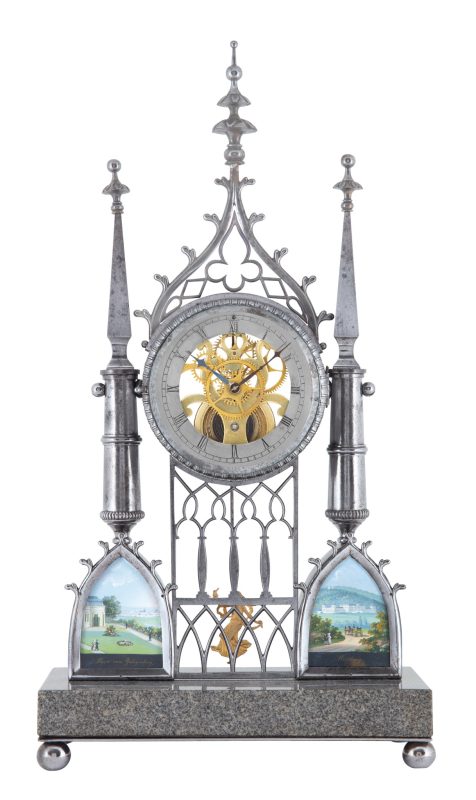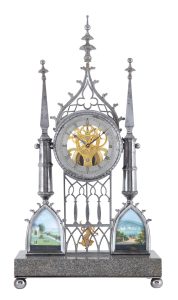Vienna, first half of the 19th century
- Case
- granite base, engraved and polished steel, two miniature paintings by Balthasar Wigand – one with a view of Vienna from Gallitzin Mountain and one of Castle Weilburg in Baden (near Vienna)
- Dial
- skeletonized dial, silver-plated dial ring
- Movement
- skeletonized brass movement, anchor escapement
- Height
- 13¼ in
This particularly finely crafted table clock combines several rare varieties of Viennese clockmaking from the first half of the 19th century. The skeletonized movement, the granite and polished steel case in the Laxenburg Gothic style and two incomparably fine vedutas by the famous miniature painter Balthasar Wigand – all of these are extremely sought-after, precious variants of Viennese craftsmanship from that era.
Resting on the granite base is an architectural structure in the Laxenburg Gothic style – an Austrian neo-Gothic movement of the first half of the 19th century. This style is delicate, often based on arched late Gothic architectural elements and of the highest elegance. The two pointed-arched plinths with crockets are engraved on the reverse. Glazed miniature paintings with a view of Weilburg Castle in Baden and a Vienna veduta from Gallitzin mountain (Wilhelminen mountain) are inserted into their fronts. Two short columns with pinnacles support the round movement case, which is crowned by a gable with tracery, crockets and a crop. The case drum is glazed on the front and back to showcase the skeletonized brass movement.
A clock of the same type – also with miniatures by Wigand – is published and illustrated in Frederik Kaltenböck’s standard work “Die Wiener Uhr”. Another timepiece with a comparable case can be found in the Sobek Collection (Geymüller castle, Vienna), which is also illustrated in Klaus Maurice’s book “Die deutsche Räderuhr”.

